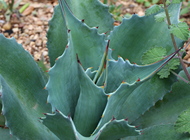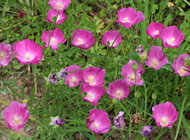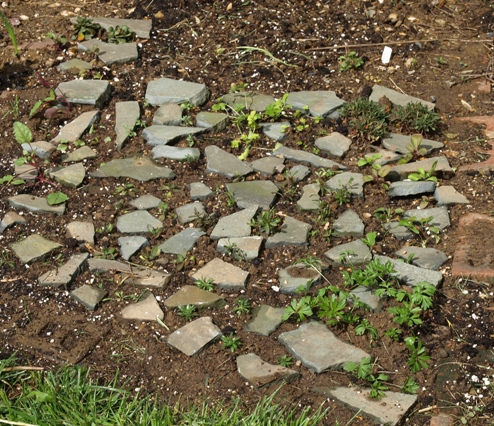 |
Garden journal entry |
 |

In time, the plants should fill out so they take up more of the interrock space |
April 27, 2012. All of my perennial seedlings spend their first season in my orchard nursery area, to grow to a large enough size to survive in one of the regular garden areas (or into the plant sale, as the case may be). The nursery area is divided into about 20 sections by rows of bricks, which makes it easier for me to record and recall which plants I've placed where. It also conveniently divides the area into sections with more or less sun exposure, and better or poorer drainage. The two areas with most sun exposure are where most of my smaller rock garden plants start out their outdoor life. To accommodate their wishes for excellent drainage, I've amended the soil in those sections with sand and grit. Sure enough, the drainage is pretty good – but that brings the opposite problem: keeping them supplied with enough moisture through the hottest weeks of summer. Rock gardening is not synonymous with xeriscaping: many of those little plants appreciate and require a regular supply of water, which can be difficult to provide in a free-draining, unmulched expanse of sun-soaked garden. Partly as a consequence of this (but also due to the fact that even the best draining soil cannot make up for the winter conditions in Pennsylvania, which aren't friendly to plants requiring dry crowns through winter), I lose more than half of the plants I set into these sections every year. What's worse, the soil conditions are perfect for frost-heaving my plant markers (strips of vinyl blinds), so that in early spring I get to look at something resembling the aftermath of Mount St. Helens' eruption: tags laying criss-cross everywhere across the bed, with little indication of what should be where. This spring, I decided to try something new: I broke up a bunch of flat bluestone rocks left over from garden pathway projects into irregular pieces a few inches on a side, and have started placing these shards around the seedlings as I'm setting them out. I also make sure to stick the plant markers all the way down into the soil, and setting a shard on top of them. The effect, I hope, will be to provide a mulch of sorts for the small plants; one that doesn't collect water as organic mulches do, and that won't get incorporated into the rest of the soil as pebble or gravel mulches would. But it should still serve prevent evaporation, thereby keeping the soil underneath the rocks cooler and moister, while allowing all the water that lands onto the bed (from rain or overhead watering) to find its way into the soil. Meanwhile, I hope the rocks will keep those plant markers in place through winter. Of course I won't know if this is just a waste of time till much further into the season – and the final verdict won't come until next spring. For now, it just looks like a strange patchwork of rocks. Which suits me fine.
The smallish area shown in the photo holds a surprisingly large number of plants, including anemones, several species of draba, penstemon, and limonium, and erigeron. |
Last modified:
September 09, 2009
Contact me
|